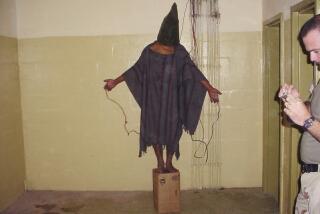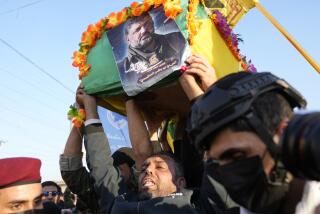U.S. ‘Phantom Brigade’ Slowed by POWs : Offensive: 3rd Infantry unit, spearheading the drive into Iraq, meets little opposition. But mass surrenders are frustrating.
- Share via
WITH THE 'PHANTOM BRIGADE,' Iraq — They seemed to come from everywhere and nowhere, prisoners materializing in the desert, white flags suddenly visible across the sand.
Tattered, thin and hungry, many had fled a remote Iraqi training camp as it was taken under fire by this advancing U.S. Army brigade. Now they were coming forth from all directions to tender their surrender.
Others said they had been walking for days, headed south from their military posts and the horror of the allied air bombardment and toward the promised generosity of the American invaders.
Some still carried the leaflets dropped as part of a U.S. psychological warfare campaign, each one depicting a crude caricature of a forlorn Iraqi soldier encircled by American battle tanks.
And as this 1st Armored Division plowed northward over little-defended terrain, its tanks and armored personnel carriers in a flying wedge across the desert, it seemed for most of the afternoon as if that cartoon had become reality.
“Iraq is Arab, and Kuwait is Arab,” one apologetic Iraqi soldier told his Army captors. “I don’t know why we want Kuwait.”
U.S. officers in this brigade, which took its first three prisoners early Monday afternoon, started off according to a grand plan that called for military police to escort each small group toward interrogators at the rear.
But the numbers soon swelled beyond imagination as the Army continued its northward march, with more white flags and handkerchiefs waving at every mile, and soon the task of taking prisoners had become almost overwhelming.
Tanks and other armored vehicles waited in their tracks and an entire division halted its advance as soldiers scurried to round up the Iraqis who made clear long before a shot was fired that they would rather quit than fight.
“You’ve been victimized by success,” the division commander, Maj. Gen. Ronald H. Griffith, assured his subordinates by radio.
But the slowdown was frustrating to American commanders whose prisoner collection resources were quickly overwhelmed.
“What does Saddam do?” asked one stunned American soldier, a driver in a Bradley Fighting Vehicle, “just take people off the streets and give them guns?”
“Ain’t going to be nobody left to fight,” grumbled his commander, Maj. Roy Adams, only half in jest as he stood grimy-faced in the turret. As brigade operations officer, he had become a director of the roundup.
A few miles forward, a Cobra attack helicopter was hovering behind two dozen prisoners, herding them as they marched south obediently. In their haste to surrender, they had flagged down the chopper as it patrolled the desert.
Another Cobra fired a few shots at an Iraqi armored vehicle before its passengers and crew piled out in haste, waving the white flags they seemed to have ready for the occasion.
But more typical as the prisoner tally for this brigade alone climbed from the scores into the hundreds were the Iraqis who walked toward advancing armored vehicles, unarmed and their uniforms almost unrecognizable, often carrying little but a canteen and a rudimentary gas mask.
First, there would be two or three appearing in the middle of the desert. And then, as the brigade moved in to attack the training camp, they came in groups of 20, 30 or more, having scattered in four directions as the Americans rumbled north.
By nightfall, what began as a novelty had clearly become a burden. Asked how many prisoners he had gathered in what was perhaps his battalion’s 15th roundup of the afternoon, Lt. Col. Pat Egan had given up his careful count.
“I got a ‘load of ‘em,” he said.
The brigade had launched into Iraq at 4:30 p.m. Sunday, roaring through gaps blasted through an Iraqi border berm in a wide-flank armored attack in which commanders were so confident of encountering no immediate opposition that all headed into battle with hatches open to the sky.
The unit, detached from the 3rd Infantry Division, served as the advance guard for the 1st Armored Division in the centerpiece of the 7th Corps attack.
The massive Army overland assault, from a position well to the west of Kuwait, was launched about 12 hours after the U.S. ground offensive began, in what was to be the main American strike force in a bid to penetrate deep within Iraq.
A gunner held up a sign that said “Welcome to Iraq,” and the brigade commander, Col. James Riley, came on radio to remind his men that they were about to qualify for the combat duty patch that soldiers wear on their right side.
“When we cross that line,” he said, “shift that Marne (3rd Infantry) patch from the left side of your helmet to the right, because that’s where it will belong.”
The division met no enemy resistance in its first hours of the offensive, and suffered its only casualties in a minor auto accident and the explosion of a dud artillery shell that left three soldiers wounded.
“The soldiers know this is the way home,” said Maj. Adams, the brigade operations officer, as thousands of tanks, armored personnel carriers and other vehicles began to head north in a battle formation that stretched across the horizon. “And it’s the right thing to do.”
The initial move north came on a gusty, gritty day that turned the desert dusky with blowing sand; most helicopters were grounded, and tanks rumbled in vast formations across the desert with no forward guard.
Soldiers wore chemical protective suits and had taken pills designed to ward off the effects of nerve gas.
This report, held up by the Pentagon’s pool system and reviewed by military censors, was written before the U.S. VII Corps plunged into a tank battle against Iraq’s Republican Guard.
More to Read
Sign up for Essential California
The most important California stories and recommendations in your inbox every morning.
You may occasionally receive promotional content from the Los Angeles Times.












